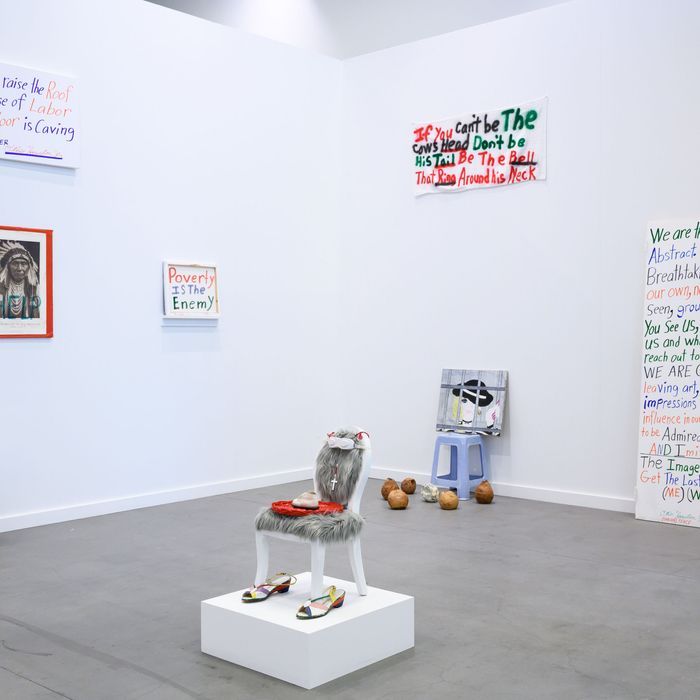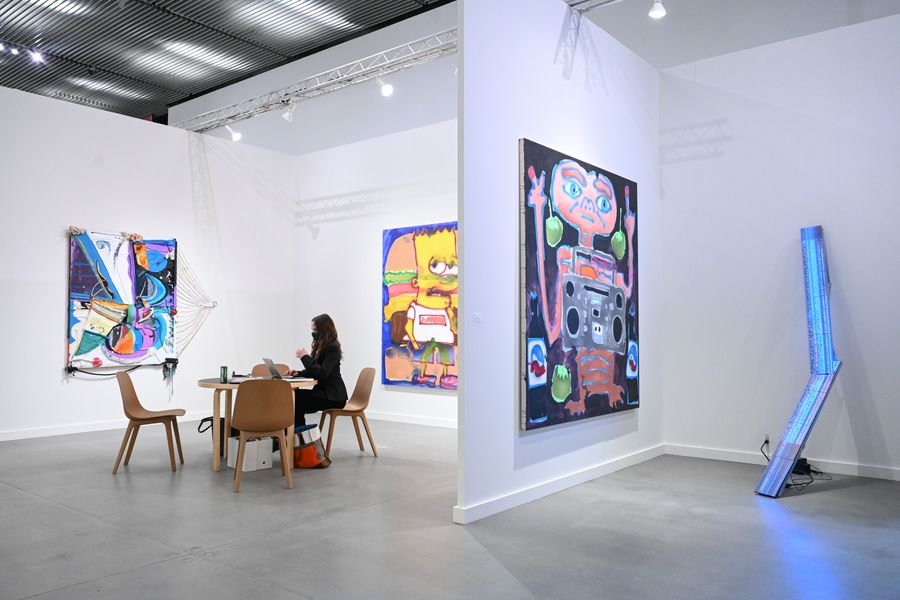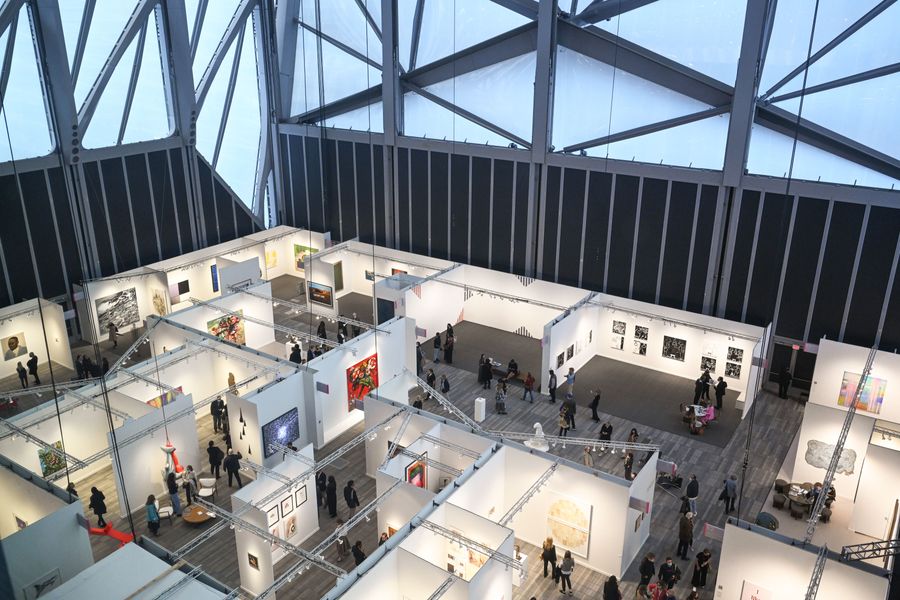
How surreal is it that even as India and Brazil are at the gates of pandemic hell, much of Europe is still easing out of lockdown, parts of Canada remain shut down, and many in the United States are not yet vaccinated, a big, glitzy art fair was able to open in New York? Does the return of the fairs signal a return to the old business-as-frenzied-usual that, even pre-pandemic, everyone agreed had become obscene — an art world catering mainly to the ultrarich, performing power and price-fixing in plain view? Is it a sign of mindless addiction, of a market endlessly self-replicating — or is it an affirmation of art as a transformative force, a site of communality and can-do spirit?
Last week saw the latest iteration of Frieze New York, the hippest of the hundreds of global art fairs that, pre-pandemic, had become some of the most economically risky but necessary components of financial survival on the nonstop money-go-round art-world trading floor. These fairs burned more spiritual and caloric energy than they ever put out. Greater and greater percentages of annual sales took place at these massive convergences, while gallery foot traffic dwindled and actual art shows went nearly unseen; galleries had to participate in fairs or go under. If they threatened to pull out, they risked triggering their artists’ FOMO — and possibly defection for more monied pastures. It was a system no one liked but that no one knew how (or was willing) to stop because it supported thousands of galleries and tens of thousands of artists in sales. Even if many of those galleries and artists were no good, the art-fair system had the power to turn art-world trickle-down into a gushing market firehose.
The multi-city behemoth Art Basel canceled its 2020 shows; it and other fairs did manage to host online events that, in some cases, did well. But Frieze New York is the first of the megafairs to reopen in person. Hugely scaled down from nearly 200 galleries to 64 commercial galleries and non-profits, Frieze decamped from its usual Randall’s Island tent to one of the ugliest corporate monstrosities built in the past decade, the pharaonic hull known as The Shed. It turns out this overscaled mall-entertainment complex makes a perfect convention hall. Frieze looks so good here that it suggests that this is what this place is best suited for. (Or maybe it should just be torn down, along with the Vessel.)
COVID protocols, including filling in digital forms for contact tracing and timed admission, made for bottlenecks at the gate. (When I saw a collector in the VIP line try to take a swipe at someone who had just served him a legal summons, apparently for a lawsuit involving a dispute over a painting, I knew I was back in the art world.) Once inside, everything felt safe. The fair was spread out over several levels, connected by escalators that felt as long and steep as those in the London subway. Perhaps because of COVID restrictions, there were very few rest areas. (A fashion observation: I saw only one pair of high heels in the entire fair. Good news for those who wear and curse them, and for short men — hi!) Participants ran from non-profit spaces to megagalleries, who shelled out, according to Frieze officials, between $10,000 and $80,000 for a booth. I’ve always thought art fairs got this wrong. They should pay galleries to participate. Still, even in its aesthetically pre-approved, economically restrictive form, Frieze provides a nice cross-section of the art world of 2021.
Through the blur of hundreds of works of art, the fair stuck the landing: Work stood out, and some stayed with me. In 2017, painter Dana Schutz became the center of controversy when the Whitney Biennial included her portrait of Emmett Till in his casket. A protest erupted. Lessons were learned. Schutz had always contorted faces and bodies in her work, but the clear identification, in this case, of Till so brutally murdered at the hands of racists, was an overstepping and a miscalculation of representational privilege. “I don’t know what it is like to be black in America but I do know what it is like to be a mother. Emmett was Mamie Till’s only son,” she said in a statement at the time. “I don’t believe that people can ever really know what it is like to be someone else (I will never know the fear that black parents may have) but neither are we all completely unknowable.” The museum kept the painting on view, nevertheless, and all the weight of the controversy fell on her. Schutz is still a great painter and has emerged to reclaim her name at her new gallery, David Zwirner, showing five fairly tremendous paintings at Frieze. Her mastery of the color of red is almost unmatched, her paint handling in control, while her surfaces seethe with visual activity.
Similarly, at Canada Gallery (always home base for talented painters), Katherine Bernhardt’s new, more structured figurative paintings of Bart Simpson and hamburgers are a cross between electric Mark Rothko and phosphorescent graphic fields of the ionosphere. Otis Houston Jr., a 67-year-old artist whose self-taught practice was seeded by an art class he took in prison, displayed a number of handpainted signs at Gordon Robichaux that spoke like political soothsayers: “You can’t raise the Roof of the House of Labor if the Floor is Caving in,” reads one. Elsewhere the intensely colored, hard-edged, super-graphic geometric paintings of Sarah Morris at White Cube may baffle some because of their slick commercial-looking optical pop, but they are undeniable. New sculptures by Rachel Feinstein at Gagosian feel more insistent than ever: See the small, monochromatic bas-reliefs of porno scenes, their detailed penises with flanges, creased vulvas and abstract beds. I only caught a snippet of Precious Okoyomon’s video, but their multimedia musical and spoken performance was enough to tell me that this is an artist to really watch. Most of the art at Frieze may not be all that radical or bold. But if you get quiet inside, you can be transported.
I’ve always freaked out at art fairs. After five or six booths, I go art-blind. I’m optically over-stimulated and geographically addled. After auctions, art fairs are, for me, the worst places to actually see art: They have to be built out within days for exhibits that will last days, so most of what you see has to be mobile enough to transport and possible to install on temporary walls. (That’s why the booths generally favor paintings.) I only go to local fairs now; at out-of-town fairs, I end up feeling sorry for myself every night alone in my hotel room, because while I’m lucky enough to be invited to everything, I’m not socially equipped to go to anything. After a few years of staring out of hotel windows and eating minbar food, I resolved to never cross water for an art fair.
Still, even though I didn’t have to leave New York, I was a mess the day I went to Frieze. You might have been too. It was the first time I’d really been in a crowd in over a year. I was scared to be social; I wanted to lose the eight pounds I gained during COVID; when I put on my shirt, it gapped from my moobs. My lifelong bashfulness and social skittishness bubbled back to the surface. Usually I cover for this by being a gregarious blabbermouth in public and scurrying home early, my cloak of shyness never completely pulled back.
Like many in the art world, I work alone and see almost no one for days or longer at a time. Other than going to 25 to 30 gallery and museum shows a week for my work — where I keep to myself, on duty, taking notes — for me, art fairs are magnificent snorkeling trips to the most exquisite and strange aesthetic-visual-social coral reefs in the world. Here I see all varieties of art-world life animated into being, all this activity going on all around me. Last week, I seemed to hover through and above it all. Faces were familiar, like a first day back at school. The crowd was rife with art-world lifers like me, people who came here before the money arrived in the late 1990s. I saw pecking orders re-established and scent trails left. I watched gorgeous stylish creatures who looked like orchids, who fashioned their looks on their own from whatever was at hand.
Most of all, I saw more artists, dealers, and collectors of color than I have ever seen in a big fair like this. One of the themes of this year’s Frieze was a “Tribute to the Vision & Justice Project,” with a focus on the work done by Harvard professor Sarah Elizabeth Lewis around art, race, and citizenship. At an art fair like Frieze, which is all about hype, hustle, and selling to the megarich, this could be seen as more white people’s window-dressing and conscience-easing. But there’s no denying that the art world is in demographic spin, with collectors buying great numbers of works from artists of color. It is a huge relief to see the art world starting to look at least a teeny tiny bit more like the real world.
Still, the current system is built on an insane paradox. The art world says it is politically and socially radical; every other artist, gallery, critic, and collector maintains they’re trying to change the world for the better, intervening for this or that social cause. (A lot of artists should just be social workers.) At the same time, this ultraprogressive world is funded in large part by hardcore Republican types, Trumpers, corporate raiders, criminal oligarchs — most of whom look on those in the art world as dumb clucks, weird creatures, prey that they can pay to be around, while gaining social clout and also possibly laundering their money. Still, it’s the job of the art world to take that money. My job is at the end point, too, of one of those trickles.
All that cash is partly what stopped many art galleries from closing during the pandemic. That, and the fact that galleries didn’t have to spend fortunes participating in art fairs, flying to biennials and museum openings. A lot of galleries survived. That’s great. However, it also means that the possible larger reckoning I saw coming never came. I thought that on the other side of the pandemic there could be wide swaths of new galleries and artists taking the stage, creating new galleries and -isms in depressed commercial real estate. Frieze Art Fair suggests that whatever changes will come will come mainly through the systems that are already in place. I imagine that, in four or five years, possibly sooner, there could be 200 or more art fairs back in operation, resolutions of smallness and sustainability set aside.
Both times I visited the fair, I drifted in the bardo between life, art, myself, the recent past, social change, market madness, fears about the future, and possibility, in a kind of inflamed haze. All the while, I was stopping; looking; staring; engaging in short exchanges with friends, strangers, and colleagues— anyone, really. Not to go full Springsteen–in–“No Surrender,” but at Frieze, I remembered that we learn more from a three-minute conversation about art “than we ever learned in school.” Art fairs can be places where ideas are challenged, your mind is changed, you glean things from perfect strangers, and share intimacies with people you never expected to feel close to. Then you move on. As crazy as it makes me, this two-step of intense engagement and retreat into solitude is my ideal social state. I am in a place, but also 30,000 feet above it, with a metaphysical escape hatch always available.
I walked home from Frieze happy. Yet I knew what I knew the day the gallery world shut down in March 2020: We should never go back to being high on our own fumes, with prices ever escalating so that only a few could play in this decadent playground, those at the top soaring away from the rest. The smaller size of this fair suggests that all the elephantine fairs with hundreds of booths should become things of the past. More scaled-down boutique fairs — like this one, the Independent, Outsider Art Fair, and L.A.’s Felix Art Fair — would be a welcome, less-frantic wave. I truly hope we never go back to seeing more than 300 fairs a year again. We rightly worry about how much carbon an NFT burns; ask yourself what these wingdings for the superrich cost in carbon. Let’s hope and demand that systems continue to change and become more representative — or the art world will continue to be rich but rotten at its core.
When it’s safe, go to the next local art fair near you. Drift, and be glad to touch antennae with maybe the most curious tribe in the world, engaged in one of the most wonderful things our species does — explore consciousness in form. Then go home and buy larger shirts.




